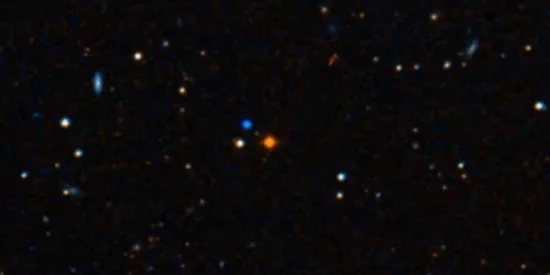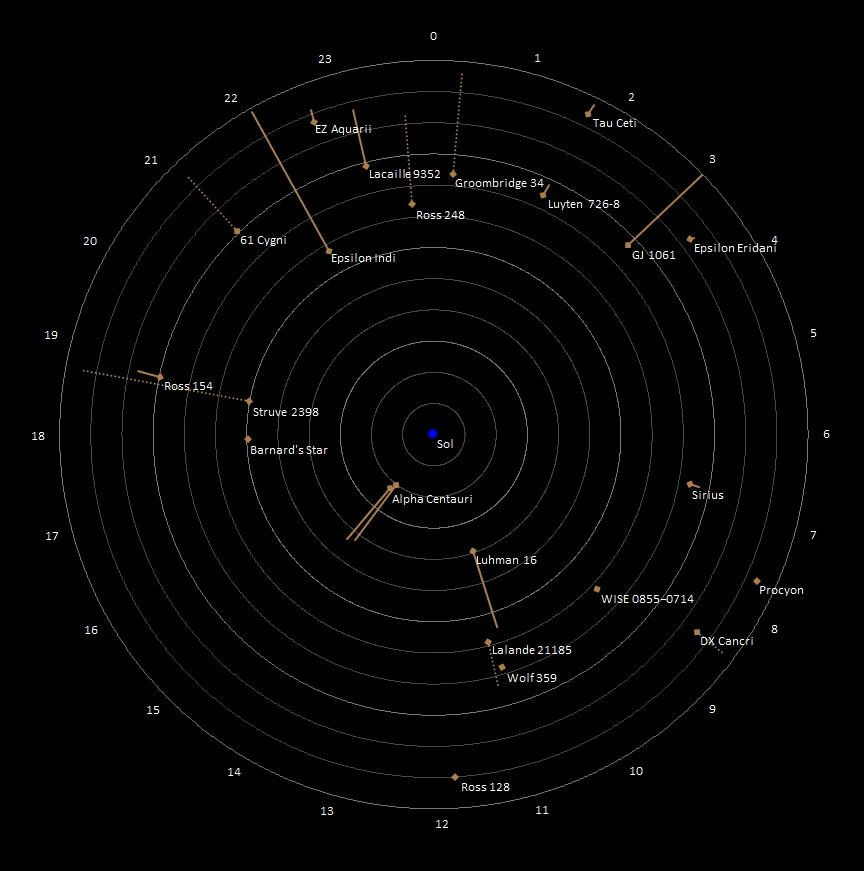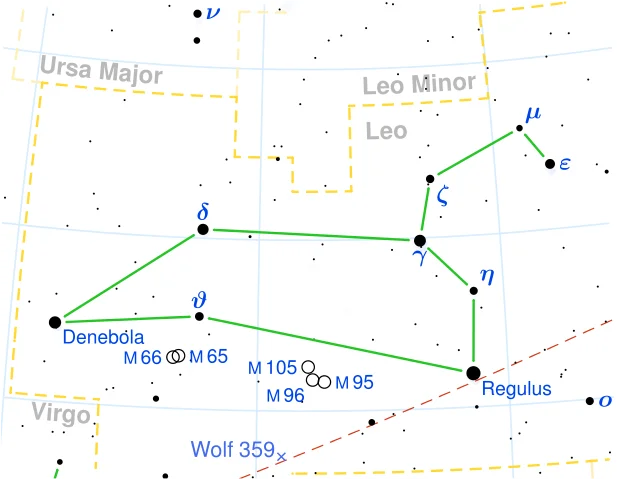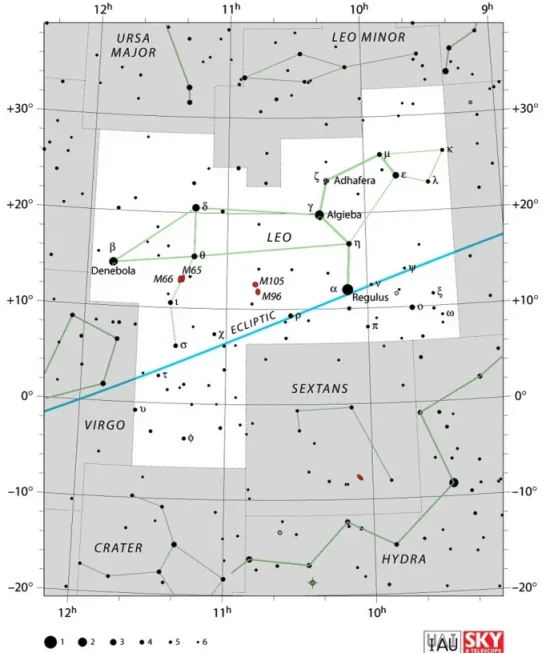Wolf 359 (CN Leonis) is a faint red dwarf located only 7.86 light years away in the constellation Leo. It is one of the nearest stars to the Sun. With an apparent magnitude of 13.54, it is invisible to the unaided eye and can only be seen in larger telescopes. The star hosts two exoplanets, designated Wolf 359 b and c, both discovered in 2019.
Star type
Wolf 359 is a red dwarf star of the spectral type M6.5 Ve or dM6. The suffix “e” indicates emission lines in the star’s spectrum.
With a mass of 0.09 solar masses, Wolf 359 is one of the lowest-mass stars known. Its mass is just above the lowest limit (0.08 solar masses) at which a star is massive enough to ignite stable hydrogen burning in its core. Objects with less than 0.08 solar masses are known as brown dwarfs and they cannot trigger sustained nuclear fusion of hydrogen into helium.
Due to its small size, Wolf 359 is fully convective, which means that the helium generated in the star’s core is transported to the surface by mass movement of plasma. Stellar models suggest that all red dwarfs with a mass less than 0.35 solar masses are fully convective. This prevents the buildup of helium in the stellar cores and prolongs the period of fusion, allowing low-mass red dwarfs to maintain the same spectral type and luminosity for trillions of years before they run out of fuel. Wolf 359 will stay on the main sequence, burning hydrogen into helium, for 8 trillion years. Since it has less than 0.25 solar masses, it will never become a red giant.

Wolf 359 (CN Leonis), image: Wikisky
Wolf 359 has a radius only 16% of the Sun’s and shines with 0.0014 solar luminosities with an effective temperature of about 2,800 K. If it replaced the Sun at the centre of our solar system, it would appear only ten times brighter than the full Moon.
The radius of 0.16 solar radii was determined by a 1990 study that combined optical and infrared photometry of red and orange dwarfs, including Wolf 359. The study gave the stellar classification M6.5e for the star.
Wolf 359 is a relatively slow spinner, with a projected rotational velocity of less than 3 km/s. It is relatively young, with an estimated age between 100 and 350 million years.
A study published in 2005 derived an age between 200 and 350 million years for the star based on modelling its spectral energy distribution and on the results of a 1993 study that had not detected any lines of lithium in the spectrum of Wolf 359. The absence of lithium indicates that the element must have been used up by the fusion in the star’s core and that the star is at least 100 million years old. The 2005 study derived an age of 200 – 350 million years and a mass of 0.1 – 0.09 M☉ from a measured effective temperature of 2,800 K and a luminosity of -2.95 L☉.
In 2003, a spectroscopic survey of red and brown dwarfs identified prominent FeH (iron hydride), CrH (chromium hydride), H2O (water), CH4 (methane) and other molecular bands in the spectrum of Wolf 359. The study also found absorption lines of titanium(II) oxide (TiO).
Wolf 359 is a flare star, a variable star of the UV Ceti type that can undergo sudden increases in brightness across the spectrum. The flares typically last only a few minutes. They are caused by magnetic activity in the star’s atmosphere. Wolf 359 has a relatively high flare rate and the strength of its magnetic field varies with periods as short as six hours. The flares emit X-rays and gamma rays. In 1995, observations with the Hubble Space Telescope revealed 32 flare-like events over a period of 2 hours. Most of these events were microflares.
Most flare stars are faint red dwarfs. Other well-known examples of this variable class in the Sun’s neighbourhood include Proxima Centauri and Barnard’s Star, the first and fourth nearest stars to the solar system.
Planets
Wolf 359 hosts two candidate planets, both discovered in 2019 using the radial velocity method. Neither planet orbits in the star’s habitable zone, which is between 0.024 and 0.052 astronomical units from the star. Wolf 359 c is too close to the star to harbour life while Wolf 359 b is too far.
The habitable zone of a star (also called the Goldilocks zone) is defined as the range of orbits from the host star where liquid water may exist on a planet’s surface. If a planet is too close, it is too hot for water to remain in liquid state and, if it is too far, it is too cold and water is frozen.
The two planets were detected in a survey of 426 nearby red dwarfs, which revealed 118 candidate exoplanets orbiting these stars, including a cool super-Neptune and a hot super-Earth orbiting Wolf 359. The study, led by the Finnish astronomer Mikko Tuomi from the University of Hertfordshire, concluded that red dwarfs host at least 2.39 planets on average.
Wolf 359 b has a mass of about 43.9 Earth masses (0.1381 Jupiter masses) and orbits Wolf 359 with a period of 2,938 days at a distance of 1.845 astronomical units.
Wolf 359 c is less massive and much closer to its host star. It has a mass of 3.8 Earth masses (0.012 Jupiter masses) and orbits the star from a distance of 0.018 astronomical units with a period of 2.68687 days.
Facts
Wolf 359 is the fifth nearest star to the Sun, after Proxima Centauri, Toliman and Rigil Kentaurus in the Alpha Centauri system, and the red dwarf Gliese 699, also known as Barnard’s Star. The brown dwarfs Luhman 16 and WISE 0855−0714 are also closer. Wolf 359 is closer to us than our brighter neighbours Sirius, Procyon, and Epsilon Eridani.

Nearest stars to the Sun, image: Wikimedia Commons/Nsae Comp (CC BY-SA 4.0)
The nearest neighbour to Wolf 359 is Ross 128, a red dwarf appearing near Zavijava (Beta Virginis) in the constellation Virgo. Even though they would not appear close in the sky if they were visible, the two red dwarfs are separated by only 3.79 light years, which is less than the distance from the Sun to Proxima Centauri (4.2465 light years). Ross 128 lies 11.007 light years from the Sun. Like Wolf 359, it is classified as a flare star.
Wolf 359 is also a close neighbour to Lalande 21185 in Ursa Major at 4.1 light years. Lalande 21185 is the brightest red dwarf in the northern sky, but still invisible to the unaided eye with an apparent magnitude of 7.520. Located only 8.31 light years from the Sun, it is also one of our nearest neighbours. Wolf 359 is close to other stars in the solar neighbourhood, including Sirius (9 ly), Procyon (8.6 ly), Luyten’s Star (9.8 ly), Wolf 424 AB (7.3 ly), Proxima Centauri (8.2 ly) and Alpha Centauri AB (8.3 ly).
The parallax of Wolf 359 was first measured at Mount Wilson Observatory in 1928 and reported as 0.407 ± 0.009 arcseconds. The measurement allowed astronomers to estimate the distance to the star.
Wolf 359 made its closest approach to the Sun 13,850 years ago, when it came within 7.329 light years (2.247 parsecs). It is now moving away from the Sun at a velocity of about 19 km/s.
Wolf 359 has a proper motion of 4.696 arcseconds per year. Its space velocity indicates that it is an old-disk star. Its orbit through our galaxy will take it within 20,500 light years of the Galactic Centre and as far away as 28,000 light years.
Wolf 359 was the first star other than the Sun to have the emission lines from its stellar corona observed from a ground-based telescope. In 2001, the astronomers who conducted the observations reported the detection of highly ionized iron (Fe XIII) in the corona of Wolf 359, which is an indicator for cool coronal plasma.
Wolf 359 was the faintest and lowest-mass star known until 1944, when Van Biesbroeck’s star (VB 10) was discovered by the Belgian-American astronomer George van Biesbroeck. Located in the constellation Aquila, VB 10 has a mass of about 0.075 solar masses and shines with only 0.0004 solar luminosities. Like Wolf 359, it is a red dwarf classified as a UV Ceti variable. It lies 18.72 light years from the Sun.
Like other nearby stars, Wolf 359 is often used in works of fiction. Notable uses in literature include the novels The Space Pioneers (1953) by Carey Rockwell, Captive Universe (1969) by Harry Harrison, Terry Pratchett’s The Dark Side of the Sun (1976), Jack McDevitt’s Chindi (2002), and John Ringo’s There Will Be Dragons (2003) and the Troy Rising (2010-2011) trilogy, and the short stories “Proposal” (1952) by L. Sprague de Camp, “The Outcasts” (1958) by George H. Smith, and “Who’s Afraid of Wolf 359?” (2008) by Ken MacLeod.
In film and television, Wolf 359 was memorably used in Star Trek: The Next Generation and Star Trek: Deep Space Nine as the site of a battle between the Federation and the Borg, and in the episode “Wolf 359” (1964) of The Outer Limits.
Name
Wolf 359 does not have a proper name and is only known by catalogue designations, including Wolf 359, Gliese 406 (GJ 406), and the variable star designation CN Leonis.
The designation Wolf 359 comes from a 1919 catalogue of stars with high proper motions published by the German astronomer and astrophotography pioneer Max Wolf, who was the first to measure the star’s proper motion in 1917. He listed the star as entry number 359 in his catalogue and the designation became widely used.
Wolf 359 was given the variable star designation CN Leonis after the first detection of a flare from the star in 1969, which led to its classification as a flare star.
The designation Gliese 406 (GJ 406 or Gl 406) comes from the Gliese Catalogue of Nearby Stars, published by the German astronomer Wilhelm Gliese in 1957. The catalogue includes 915 known stars in the solar neighbourhood, within 65 light years (20 parsecs) of the Sun.
Location
Wolf 359 lies near the ecliptic, south of the imaginary line connecting the bright Regulus and Denebola in Leo. With an apparent magnitude of 13.54, the star cannot be seen in binoculars. It can only be observed in larger telescopes.

Wolf 359 location, image: Torsten Bronger (CC BY-SA 3.0)
Constellation
Wolf 359 is located in the constellation Leo. Stretching across 947 square degrees, Leo is the fifth largest northern constellation and 12th largest of all 88 constellations. It is easily recognizable for the Sickle asterism, which outlines the Lion’s mane and shoulders.
Leo is one of the 48 Greek constellations, first catalogued by the Greek astronomer Ptolemy in the 2nd century CE. It represents the Nemean lion, a Greek mythical monster that met its end at the hands of Heracles as part of the hero’s Twelve Labours.

Leo constellation map by IAU and Sky&Telescope magazine
Leo is one of the several constellations that look like the animals they represent. The constellation’s brightest star Regulus marks the celestial Lion’s heart, the stars of the Sickle outline the mane, Zosma and Chertan the rump, and Denebola the tail.
Notable stars in the constellation include Regulus (Alpha Leonis), the 21st brightest star in the sky, Algieba (Gamma Leonis), a binary system composed of two giants, the white giant Adhafera (Zeta Leonis), the carbon star CW Leonis, the white supergiant Eta Leonis, Icarus (MACS J1149 Lensed Star 1), one of the most distant stars known, and Caffau’s Star (SDSS J102915+172927), one of the oldest stars known in the Milky Way with an estimated age of 13 billion years.
Leo is also known for its several bright galaxies. These include Messier 65, Messier 66 and NGC 3628 in the Leo Triplet (M65 Group), and Messier 95, Messier 96 and Messier 105 in the Leo I Group (M96 Group). Other relatively bright galaxies in the constellation include the elliptical galaxy NGC 3842, the brightest member of the Leo Cluster of galaxies, the Silverado Galaxy (NGC 3370), a spiral galaxy 98 million light years away, NGC 3226 and NGC 3227, an interacting pair about 77 million light years away, and the Cosmic Horseshoe, a gravitationally lensed system of two galaxies located 5.2 and 10.3 gigalight years away, discovered in 2007. Leo also contains the Frosty Leo Nebula, a preplanetary nebula, and the Owl Galaxy (NGC 3758), a galaxy with a binary black hole.
The best time of year to watch the stars and deep sky objects in Leo is during the spring months, when the constellation is prominent in the evening sky. The entire constellation can be seen from locations between the latitudes 90° N and 65° S.
The 10 brightest stars in Leo are Regulus (Alpha Leo, mag. 1.40), Algieba (Gamma Leo, mag. 2.08), Denebola (Beta Leo, mag. 2.113), Zosma (Delta Leo, mag. 2.56), Epsilon Leonis (mag. 2.98), Chertan (Theta Leo, mag. 3.324), Adhafera (Zeta Leo, mag. 3.33), Eta Leonis (mag. 3.486), Subra (Omicron Leo, mag. 3.52), and Shaomin (Rho Leo, mag. 3.9).
Wolf 359
| Spectral class | M6.5 Ve or dM6 |
| Variable type | UV Ceti |
| U-B colour index | +1.165 |
| B-V colour index | +2.034 |
| Apparent magnitude (V) | 13.54 |
| Apparent magnitude (J) | 7.1 |
| Absolute magnitude | 16.65 |
| Distance | 7.86 ± 0.03 light years (2.409 ± 0.009 parsecs) |
| Parallax | 413.13 ± 1.27 mas |
| Radial velocity | +19.321 ± 0.145 km/s |
| Proper motion | RA: -3808.09 ± 0.30 mas/yr |
| Dec.: -2692.61 ± 0.42 mas/yr | |
| Mass | 0.09 M☉ |
| Luminosity (bolometric) | 0.0014 L☉ |
| Luminosity (visual) | 0.00002 L☉ |
| Radius | 0.16 R☉ |
| Temperature | 2,800 ± 100 K |
| Metallicity | +0.18 ± 0.17 dex |
| Age | 100 – 350 million years |
| Rotational velocity | < 3.0 km/s |
| Surface gravity | 5.5 cgs |
| Constellation | Leo |
| Right ascension | 10h 56m 28.826208s |
| Declination | +07° 00′ 52.34400″ |
| Names and designations | Wolf 359, CN Leonis, CN Leo, GJ 406, GCTP 2553, LTT 12923, NLTT 25782, LHS 36, LFT 750, G 045-020, CSV 6806, EUVE J1056+07.0, FBS 1054+073, GSC 00261-00377, PLX 2553.00, RBS 922, JP11 5139, JP11 5138, JP11 5140, JP11 5141, 2MASS J10562886+0700527, UBV 10028, USNO 836, USNO 612, WISEA J105626.19+070025.0 |